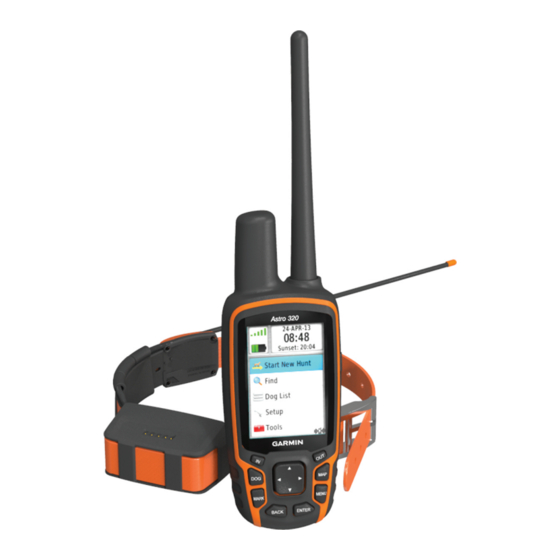Garmin Astro 320 with T5 Manuel du propriétaire - Page 9
Parcourez en ligne ou téléchargez le pdf Manuel du propriétaire pour {nom_de_la_catégorie} Garmin Astro 320 with T5. Garmin Astro 320 with T5 22 pages.

4
Move to the waypoint location.
5
Select Start.
6
Follow the on-screen instructions.
7
When the confidence status bar reaches 100%, select Save.
For best results, collect 4 to 8 samples for the waypoint, waiting
at least 90 minutes between samples.
Projecting a Waypoint
You can create a new location by projecting the distance and
bearing from a marked location to a new location.
1
From the main menu, select Tools > Waypoint Mgr.
2
Select a waypoint.
3
Select MENU > Project Waypoint.
4
Follow the on-screen instructions.
5
Select Save.
Deleting a Waypoint
1
From the main menu, select Tools > Waypoint Mgr..
2
Select a waypoint.
3
Select MENU > Delete > Yes.
Routes
A route is a sequence of waypoints or locations that leads you
to your final destination.
Creating a Route
1
Select Tools > Route Planner > Create Route > Select
First Point
2
Select a category.
3
Select the first point on the route.
4
Select Use > Select Next Point.
5
Select a point.
6
Repeat steps 3 through 6 to add all the points in the route.
Navigating a Saved Route
1
Select Tools > Route Planner.
2
Select a route.
3
Select View Map > Go.
4
Navigate using the compass
Pointer) or map (Map).
Editing a Route
1
Select Tools > Route Planner.
2
Select a route.
3
Select Edit Route.
4
Select a point.
5
Select an option:
• To view the point on the map, select Review.
• To change the order of the points on the route, select
Move Up or Move Down.
• To insert an additional point on the route, select Insert.
The additional point is inserted before the point you are
editing.
• To remove the point from the route, select Remove.
Viewing the Active Route
1
Select Tools > Active Route.
2
Select a point in the route to view additional details.
Reversing a Route
1
Select Tools > Route Planner.
2
Select a route.
Waypoints, Routes, and Tracks
(Navigating with the Bearing
3
Select Reverse Route.
Deleting a Route
1
Select Tools > Route Planner.
2
Select a route.
3
Select Delete Route > Yes.
Deleting All Routes
1
From the main menu, select Tools > Route Planner.
2
Select MENU > Delete All > Yes.
Tracks
A track is a recording of your path. The track log contains
information about points along the recorded path, including
time, location, and elevation for each point.
Recording Track Logs
1
Select Tools > Setup > Tracks > Track Log.
2
Select Record, Do Not Show or Record, Show On Map.
If you select Record, Show On Map, a line on the map
indicates your track.
3
Select Record Method.
4
Select an option:
• To record tracks at a variable rate that creates an
optimum representation of your tracks, select Auto.
• To record tracks at a specified distance, select Distance.
• To record tracks at a specified time, select Time.
5
Select Recording Interval.
6
Complete an action:
• If you selected Auto for the Record Method, select an
option to record tracks more or less often.
NOTE: Using the Most Often interval provides the most
track detail, but fills up the device memory quicker.
• If you selected Distance or Time for the Record Method,
enter a value.
As you move with the device turned on, a track log is created.
Viewing the Elevation Plot of a Track
1
Select Tools > Track Manager.
2
Select a track.
3
Select Elevation Plot.
Viewing Details about the Track
1
Select Tools > Track Manager.
2
Select a track.
3
Select View Map.
The beginning and the end of the track are marked by flags.
4
Select the information bar at the top of the screen.
Information about the track appears.
Saving the Current Track
1
Select Tools > Track Manager.
2
Select a track.
3
Select an option:
• To save the entire track, select Save Track.
• To save part of the track, select Save Portion, and select
the part to save.
Marking a Location on a Saved Track
1
From the main menu, select Tools > Track Manager.
2
Select a track.
3
Select View Map.
4
Select a location on the track.
5
